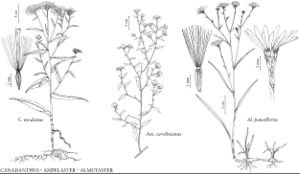Canadanthus
Phytologia 77: 250. 1995.
| Taxon | Illustrator ⠉ | |
|---|---|---|
 | Canadanthus modestus Ampelaster carolinianus Almutaster pauciflorus | Yevonn Wilson-Ramsey Marjorie C. Leggitt Yevonn Wilson-Ramsey |
Perennials, 30–100 (–130) cm (rhizomatous). Stems ascending to erect, simple, ± densely villous, stipitate-glandular distally. Leaves cauline; alternate; sessile; blades 1-nerved, elliptic-lanceolate or oblanceolate to (sometimes narrowly) oblanceolate or lanceolate, margins entire to serrate, abaxial faces glabrate to ± strigose, adaxial sparsely villous, (distal) stipitate-glandular. Heads radiate, usually in leafy, irregularly flat-topped, paniculiform to corymbiform arrays, sometimes borne singly. Involucres cylindro-campanulate, {(5–) 7–10 ×} 12–16 mm. Phyllaries 26–60+ in 3–5 series, 1-nerved (flat), lanceolate, subequal, outer ± foliaceous, inner herbaceous, bases not indurate, abaxial faces stipitate-glandular. Receptacles flat, pitted, epaleate. Ray-florets 20–65 in 1 series, pistillate, fertile; corollas pale to dark purple or rose (coiling). Disc-florets 40–65, bisexual, fertile; corollas whitish to pale-yellow, turning purple, lobes sometimes purplish-tinged, ± ampliate, tubes shorter than tubular throats, lobes 5, erect, triangular; style-branch appendages narrowly triangular (hairy). Cypselae obconic-fusiform, compressed, 4–9-nerved, faces sparsely strigose, eglandular; pappi of 20–35+ cinnamon, equal, barbellate, attenuate bristles in 1 series. x = 9.
Discussion
Species 1.
G. L. Nesom (1994b, 2000) established Canadanthus as a monotypic genus and provided justification at the morphologic and cytologic levels. According to Nesom, Canadanthus (x = 9) belongs in Symphyotrichinae, in an isolated position similar to that of Ampelaster (x = 9), Almutaster (x = 9), and Psilactis (x = 9, 5, 4); most of the species of the subtribe are in genus Symphyotrichum (x = 8, 7, 5, 4). J. C. Semple and L. Brouillet (1980) had placed Canadanthus in Aster subg. Modesti. A molecular phylogenetic study of North American asters based on restriction site analysis of chloroplast DNA by Xiang C. and Semple (1996) showed Canadanthus to be basal to Ampelaster and Symphyotrichum. The basal position of Canadanthus in subtribe Symphyotrichinae was confirmed in a phylogeny of North American and Eurasian asters using nuclear ribosomal DNA (ITS) (Semple et al. 2002). Canadanthus modestus has been associated also with Eurybia sibirica, notably by Á. Löve and D. Löve (1982b) when they created the genus Weberaster, or with E. radulina (e.g., A. G. Jones 1980; Jones and D. A. Young 1983). This may be due to similarities in the habit, foliage, and involucres of these species.
Selected References
None.